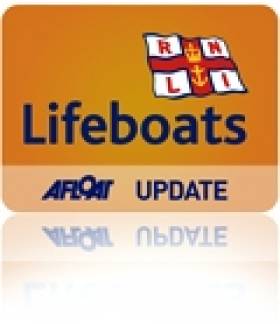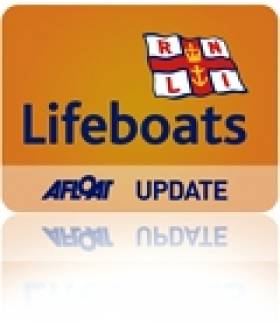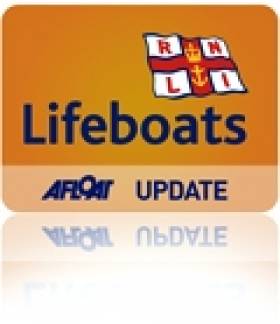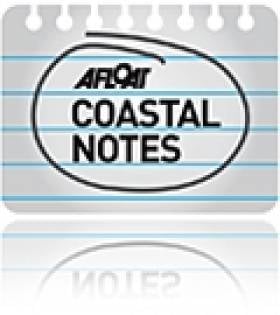Displaying items by tag: Newcastle
#rnli – The volunteer lifeboat crew at Newcastle RNLI got to put their new inshore lifeboat through its paces yesterday (Thursday 4 December) when it was requested to launch hours after arriving at station. The callout came at 6.04am in the morning when the coastguard requested the launch of Newcastle's newly arrived D class inshore lifeboat and all weather lifeboat, following reports that a 56 year old man was missing.
The weather was good and the sea state calm, giving both lifeboats the perfect conditions to carry out an intensive search. In the darkness the lifeboat crew used the search light and night vision to scan the coastline and the new lifeboat was able to move in close to the rocky coastline with the crew using their oars to check the depth. Thankfully the man was located safe on land and the search was stood down at 7.30am.
Following delivery of the £41,000 lifeboat, the crew checked it was operational and Search and Rescue capable before they set to sea. The new lifeboat is fitted with SIMS (Systems and Information Management System), an RNLI-developed means for the crew to control a lot of the boat's functions and has a single 50hp outboard engine. Capable of reaching speeds of up to 27 knots the lifeboat can also be righted manually by the crew in the event of a capsize. Equipment onboard includes both fitted and hand-held VHF radio, night-vision equipment, and a first aid kit including oxygen.
The D class lifeboat was first introduced into the fleet in 1963, and its design has continued to evolve. This new lifeboat for Newcastle in county Down was generously funded through a legacy from Mrs Mary Olga Illingworth in Sheffied, with the request that it be named Eliza in memory of her mother.
Commenting on the arrival of the lifeboat, Newcastle RNLI Senior Helm Richard Burgess said, 'The new lifeboat is great to handle and is a marked improvement on our outgoing one, which gave great service to Newcastle for many years. We are very impressed with the enhanced technology and the addition of AIS (Automatic Identification System) which aids the identification and location of marine vessels. It is fast, powerful and easy to manoeuvre; ideal for launching in a hurry. We are very grateful to the late Mrs Illingworth for thinking of others through this generous legacy in providing this lifesaving vessel.'
Newcastle RNLI Deputy Launching Authority Joe Leneghan added, 'We have a great crew here in Newcastle, who put so much time and commitment into their training on the lifeboat. Therefore it is only right that the RNLI provides the best in lifeboat technology and equipment for them. Saving lives at sea is always down to the lifeboat crew but by providing them with a state of the art lifeboat, which is fully kitted out in the latest in Search and Rescue technology they can locate the casualty faster and bring them home to their loved ones sooner. I wish the lifeboat crew many successful callouts in this new lifeboat and may she always carry them home safely.'
The lifeboat crew on the inshore lifeboat were Helm Richard Burgess and crew Declan Barry and Arron Latus. On the all weather lifeboat was Coxswain Richard Herron, Deputy Coxswain William Chambers, Mechanic Aidan Riley and crewmembers Peter Uprichard, William Wilson, Robert Latus and Daniel Rooney.
Exercise Turns Callout For Newcastle Lifeboat’s New Coxswain
#RNLI - A lifeboat training exercise in Carlingford Lough over the weekend turned into a real life callout for the volunteer lifeboat crew of Newcastle RNLI when they were tasked by Belfast Coastguard to go to the assistance of a man in a 26ft fishing vessel with engine failure.
The callout on Sunday morning (16 November) was the first for crew member Richard Burgess since he was appointed a station coxswain.
While on a crew training exercise, the all-weather lifeboat Eleanor and Bryant Girling was alerted by Belfast Coastguard to a man in a fishing vessel at Block House Island, whose boat had suffered engine failure and who was subsequently unable to make it to shore safely.
The lifeboat came on scene at 3.15pm and took the vessel under tow to Carlingford Harbour, arriving at 4pm. There they were met by Greenore Coastguard and the vessel was moored alongside the harbour wall.
The callout was a special one for crew member Richard Burgess, as it was his first in his new role as a station coxswain at Newcastle RNLI.
"It is nice to get the first callout over as coxswain and to know that it ended well with everyone safe," he said. "I’ve been on the lifeboat crew for a few years now but it has been a huge honour to be appointed one of the station’s coxswains.
"We have a strong team here in Newcastle RNLI and it is great to know that when you are heading out to sea, there is a highly trained and competent crew with you."
The lifeboat crew on the callout were coxswain Richard Burgess, deputy coxswain Alan Jones, mechanic Jim Polland, navigator Niall McMurray and crew members Gary Agnew and Daniel Rooney.
Busy Weekend With Four Call-Outs For Portaferry RNLI
#RNLI - Portaferry RNLI in Co Down had a busy weekend with four separate call-outs over the two days.
The first came on Saturday 6 July following a report that three children were drifting offshore on an inflatable toy.
The volunteer lifeboat crew was already afloat on exercise as part of the annual raft race in Kircubbin, Co Down, when they got a call to go to the aid of the three children aged 10, 11 and 14 who were drifting out to sea on the inflatable 18 miles away at Cloughey Bay.
Thankfully by the time they arrived on scene a local coastguard unit had already attended and brought the three children to safety on shore.
Portaferry RNLI was called out for a second time at 4.10pm to rescue a number of people on board a speedboat that had lost power in Strangford Lough just off Killyleagh.
The crew arrived at the scene at 4.15pm, by which time the 15ft speedboat had already been towed in and was moored at the pontoons at Killyleagh Yacht Club in Strangford Lough.
On both occasions the weather was fine with good visibility and calm seas.
Yesterday (7 July) the volunteer crew launched for the third time to assist an injured woman on Salt Island in Strangford Lough.
The crew arrived at the island at 10.10am and assessed the situation before transporting two paramedics from Killyleagh to the injured woman, who was subsequently airlifted by Irish Coast Guard helicopter to Musgrave Park Hospital in Belfast for treatment.
At 11:35am, while returning to the lifeboat station, the crew was alerted once again, this time to go to the aid of two men onboard a five metre Dory that had lost power and was drifting just off Ringhaddy Sound in Strangford Lough.
The crew arrived on the scene at 12.05pm and took the men onboard the lifeboat, towing the powerless boat into Strangford Lough Yacht Club, where the men were then put ashore and their boat tied up.
Elsewhere in Northern Ireland, Newcastle RNLI assisted two men after their motor cruiser ran aground off the Co Down coast last Thursday (4 July).
The volunteer crew launched their inshore lifeboat at 2.20pm following a report from Belfast Coastguard that a small vessel had ran aground off Dundrum Bar with two people on board.
Weather conditions at the time were described as blowing south westerly four to five winds with moderate to choppy seas. There was good visibility.
The lifeboat, helmed by Nathan Leneghan and with crew members Declan Barry and Charles McClelland on board, arrived on scene at 2.30pm, where they observed that one of the men had made it to shore while the other was still on the 5m boat.
Speaking following the call-out, Newcastle RNLI deputy launching authority Joe McClelland said: "Thankfully, no one was in immediate danger and we were happy to bring the vessel and the man who was still on board safely to shore."
Busy Days For RNLI Lifeboats In Co Down
#RNLI - Newcastle RNLI’s always-on-call lifeboat crew had to abandon their buckets and sponges during a fundraising car wash at the weekend to respond to an emergency at the Co Down town’s harbour.
The RNLI volunteers were busily soaping and rinsing cars for their annual Easter fundraiser on Saturday when they were alerted to a woman in trouble in the freezing water a few yards from one of the piers.
The car wash was immediately abandoned and within minutes the inshore lifeboat Aldergrove II was launched and rushed to the woman’s aid.
At the same time, crew member Shane Rice grabbed a lifebelt from the pier and jumped into the water to assist the woman. He kept her afloat while the Aldergrove II came alongside.
The woman was helped into the rescue inflatable, wrapped in blankets to prevent hypothermia, and taken back to shore where an ambulance was waiting to take her to hospital.
Newcastle RNLI’s deputy launching authority Clifford Moorehead said afterwards: "The lifeboat crew are always ready to respond in an instant to any emergency. It is fortunate that the car wash was in progress at the time and the crew members were on hand to swiftly deal with this case.
"After the rescue the crew members came back to the harbour and resumed their car wash. It’s just all in a day’s work for the RNLI."
It wasn't the only callout of the weekend for the RNLI in Co Down, as Bangor RNLI assisted a lone sailor who got into difficulty on a sailing dinghy Easter Sunday.
At 1.10pm the volunteer lifeboat crew received an urgent request from Belfast Coastguard to launch the lifeboat and rescue one person from a 17ft dinghy.
The sailing dinghy had reportedly gone aground on ‘Cockle Island’ off Groomsport Harbour on the southern shores of Belfast Lough.
Upon arrival at the scene, the volunteer crew found that the occupant onboard the dinghy had been assisted by another boat owner and the vessel had been safely tied to a mooring buoy.
Meanwhile, last Wednesday evening Portaferry RNLI was launched to reports that red flares has been sighted on Strangford Lough off Kircubbin in Co Down.
They were joined by a coastguard team that searched the shoreline and after some time recovered a spent flare casing. The inshore lifeboat and its volunteer crew were stood down after a number of hours with the callout proving to be a false alarm.
Portaferry RNLI lifeboat operations manager Brian Bailie said: "A member of the public acted in good faith ... alerting the emergency services to what they understood to be a distress flare on the lough."
He reiterated that flares "should only be used in emergency situations".
Search Scaled Down for Missing Crewman in Irish Sea
#RESCUE - BBC News reports that the search for a cargo ship crewman missing in the Irish Sea has been scaled down.
The 22-year-old from Slovakia was reported missing yesterday morning from the Fehn Sirius, which was en route from Belfast to Portugal, as it headed past Arklow, Co Wicklow.
According to The Irish Times, he was last seen on the cargo ship around 10pm on Monday night as it headed south of the entrance to Strangford Lough.
Lifeboats from Portaferry and Newcastle in Northern Ireland and Arklow joined the search and rescue operation, which was assisted by the RAF helicopter based at Prestwick in Scotland and an Irish Coast Guard helicopter.
However, most rescue services have now been stood down as the Fehn Sirius continues to backtrack in the Irish Sea, with assistance from the Naval Service vessel LE Ciara.
Only three days ago the body of another mariner was recovered from the Irish Sea off the north Dublin coast, more than a month after he went missing.
RS 200: the 'ideal' next step for Irish Youth Sailing?
Questions over the next step for juniors after the RS Feva point to the bigger RS200 writes Feva sailor Ciara Byrne
The RSFeva has become the world's best selling two-person dinghy in recent years with fleets also growing in clubs all over Ireland. It is fast becoming the most popular and widespread choice for teenagers and youth sailors who enjoy competitive, active and exciting sailing.
However many questions were being asked recently at the RSFeva Nationals, held in Crosshaven, Co. Cork, regarding the next step for young, talented sailors who wish to continue racing in large fleets without the difficult transition of transferring from the Feva into a larger, unfamiliar dinghy. This uncertainty has led to many sailors dropping out of sailing altogether, while the remainder have split the fleet into Lasers, the 420/470 or moved on to cruisers.
However these dinghies require a lot of time and effort of getting used to, leaving some sailors frustrated and also, less motivated. To avoid this altogether, there is one simple solution: the RS200.
The RS200 is a spacious, one-design, double-handed, hiking, high-performance dinghy which has developed a huge following at club, circuit and championship level in the UK with a growing fleet in Ireland. A pivoting centreboard and rudder allow easy launch and recovery with a thwart giving the crew a comfortable position for light winds. With the asymmetric spinnaker, similar rigging and a similar design, it can be considered as a larger and faster Feva which makes for an easy changeover and the most logical and simple step up.
The ideal weight for an RS200 is 115-145kg (18-23 stone) which allows people of all ages to sail and race effectively in this dinghy. Ideal for teenagers emerging from the Feva, parents, youths, couples, friends and relatives can also come together which enhances the family and social scene.
Even though the 420 has a larger total sail area, the RS200's asymmetric spinnaker of over eight square metres, with a smoother single line hoist and drop system, similar to the Feva's. makes for a faster boat and requires greater tactical and more exciting downwind sailing. This encourages competitive racing and enhanced racing skills.

An RS200 at full speed off Greystones. Photo: Fiachra Etchingham
A maintenance free hull, made of lightweight polyester GRP ensures a long competitive life and second hand boats can be in very good condition so that older hulls are without the disadvantage experienced in fleets such as the 420. Furthermore, every hull comes from the same manufacturer giving no subtle advantage to any one boat; therefore racing just comes down to the sailors' tactics, boat handling and general knowledge of sailing and racing.
While the RS200 is not an Olympic class, there are large UK and Irish fleets which are active and competitive. Johnathan Lewis, a UK Feva coach and RS200 sailor, strongly encourages Feva graduates to move into the RS200 as it is an easy transition and makes for fun and exciting sailing. RS200 fleets are strong in Irish clubs such as those in Northern Ireland including Ballyholme, Newcastle and Cushendall as well as Greystones Sailing Club in Co. Wicklow.
Greystones Sailing Club boasts probably the largest asymmetric dinghy fleet in Ireland with fifty five asymmetric dinghies, twenty one of those being RSFevas and the majority of the remainder being RS200s. Recognising the RS200 as the natural progression from the Feva, ages range from fifteen to fifty five across the RS200 and RS400 fleets in the Club, with most of these boats competing in national events in Ireland, and some in the UK and further afield.

Rounding a mark in the RS200. Photo: Fiachra Etchingham
As fleets build in Dún Laoghaire and Howth yacht clubs, the RS200 is gradually becoming a popular progression from the Feva, and with the RS400 as a follow on boat for larger crews, young sailors can remain involved and spirited in asymmetric racing. The RS200 satisfies a thirst for speed and pace which generates more exciting, competitive and enjoyable sailing for those emerging from Feva fleet.
A Dublin Sailor (who has asked not to be named) has sent us comments on this story:
As one involved in junior and youth sailing at club level, one of the big decisions that faces youths is where to go after junior classes such as Optimists, Toppers, Fevas. Like any other sport, there is a high attrition rate after the age of 14 / 15, especially among girls which is an even greater shame as they can compete on a par with the guys.We need a class that will keep youths engaged. The 420 & 29er are great boats but require higher levels of boathandling, are much more competitive and tend to attract the top sailors. They also suffer from an inability to match up crews who will stick together - teenagers chop and change all the time and its difficult to race a boat like a 420 / Fireball / 29er wihout a constant crew partnership.
We need a boat/class that:
- Enables swapping around of crews without a major impact on the boathandling / teamwork. A sailor's plans for the weekend / event / season are not scuppered because of crewing issues.
- Does not need a highly competent crew (e.g. ability to trapeze and fly / gybe a kite etc.) so that sailors can sail with their mates who may not necessarily be top-notch sailors but who can acquit themselves well in a slightly less complex boat.
- Has a good mixed social scene which is the most important element of any class, youth or otherwise.
- Does not cost the earth in terms of purchase price, is easy on wear & tear on kit (hence replacement & upgrade costs) or does not go soft and become uncompetitive needing a new hull after three to five years etc
- Has international competition that is closeby (UK, FR, Bel, Ned etc) for those aspiring to a bit more
- Has a motiviated class structure to help grow the class.
The fear is that we are starting out another class that will dilute the current youth class efforts. However I believe that the 420 and 29er will hold their own and continue to attract top sailors with ISAF ambitions.
On the other hand, if we continue to support these we will continue to lose the middle ground (and majority) of young sailors from our sport. Youths are fickle enough and if its too much hassle to deal with all the challenges of getting afloat they just won't bother - sad but true.
The ISA needs to take a lead in this and while its Olympic ambitions are great to see, it will fail the sport as a whole if it does not tackle this gaping need in its portfolio of support.
I believe that the RS200 and R2400 provide the best solution to these challenges. They appear well-built and the manufacturer certainly appears well organised and gets involved.
Looking from outside and without any vested interests (other than the health of junior and youth sailing) the RS's get my vote as a class that can make a radical difference.
Ireland's Bathing Spots Among Cleanest in Europe
Ireland has ranked fifth in a new Europe-wide report on bathing water quality - but some beaches in Northern Ireland are falling short of strict EU standards.
MEP Jim Higgins welcomed the results of the annual Bathing Water Report for 2010, saying: "Ireland's scenic attributes are a primary reason for attracting tourists and it is essential that our coastal and inland bathing sites are also enticing."
Ireland has moved up five places from its overall rank of 10th in 2009, with 90.1% of all bathing water sites meeting the EU's Blue Flag guidelines for water quality at beaches and swimming spots.
However, the Daily Telegraph reports that a number of beaches in Northern Ireland and other parts of the UK were judged to be 'poor'.
Beaches at Newcastle and Ballyholme in the North are among 16 across the UK that did not pass the EU's strict checks for Blue Flags.
The 2010 report ranks Cyprus as the cleanest bathing spot in Europe, with 100% of sites passing EU insspection. It was closely followed by Croatia with 97.3%, Malta at 95.4% and Greece at 94.2%.
Wicklow Boatyard at the Cutting Edge
Afloat magazine profiles Noonan Boats, one of the country’s leading repair facilities
From collision damage, keel fairing right up to osmosis treatments and re-sprays, Noonan boatyard in Newcastle, Greystones Co. Wicklow offers such a comprehensive service on the East Coast there is little need for any boat to go abroad for repairs these days, regardless of the extent of damage.
And news of the quality work has been spreading with boats from the four coasts Ireland coming to Wicklow for a range of work.
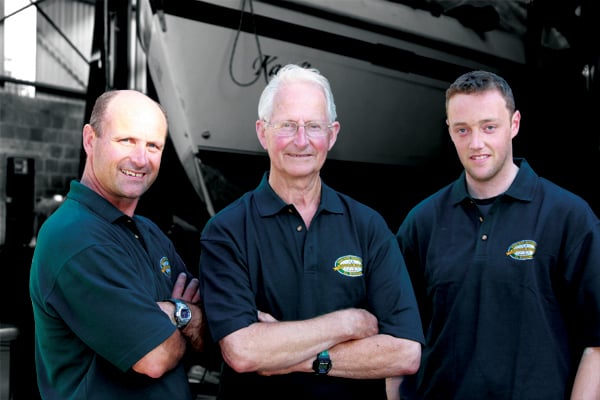
Graeme Noonan (left) has extensive big boat repair experience from his time in the marine industry in Sydney, Australia and is an active RS sailor. Founder Tony Noonan (centre) has spent a lifetime in the Irish Marine industry with Neil Watson Yachts, Wicklow Marine Services before setting up Noonan Boats in 1995. Brian Flahive is an active dinghy and keelboat sailor this year finished second in the Round Ireland double-handed class and won the Fireball National Championships.
Father and son team Tony and Graeme Noonan have over 30 years in the business and have recently expanded the premises to over 3,000 sq feet to cater for a growing range of repair work for boats up to 50 feet under cover.
They have a well-established reputation for the treatment of osmosis, to resolve hull blistering. This is a preventative and remedial process that requires specialist treatment.
The bulk of repair work comes from along the East Coast based boats and the nearby port of Dun Laoghaire but the company offers a national service to include transport to and from the Noonan boatyard if required.
“We have an established track record dealing with Insurance companies. No job is too difficult, too small or too big for us” says Tony Noonan.
Most work is carried out in in a purpose-built marine workshop containing two lifting bay facilities that includes keel and rudder repair pits but the firm also carries out on site repairs to suit too.
Repairs are carried out to original specifications and they carry out re-moulding repairs to up to date construction methods e.g. GRP foam core, Balsa core and carbon under vacuum bagging conditions.
A particular speciality is the repair of carbon repairs to dinghy masts, spinnaker poles and hulls. This has become more popular recently with the advent of carbon bowsprits on boats such as the J109s and SB3s.
Keel fairing, the process of improving the accuracy of the shape of a keel to improve boat speed is also high on the jobs list.
The company also has the specialist hot weld equipment to carry out the repair of polyethylene materials as used in the RS Feva and Laser Pico dinghies.
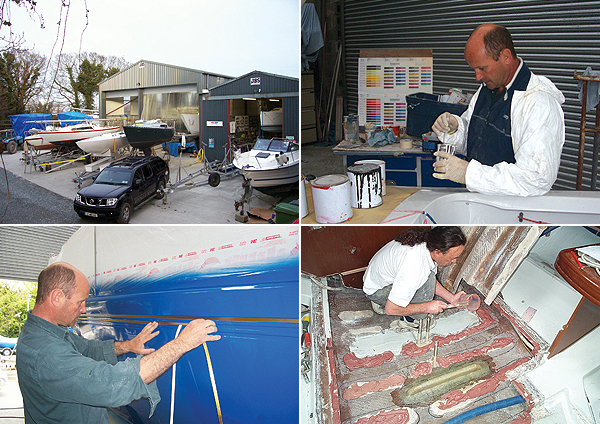
Colour Matching
Making a fibreglass repair to bring a boat back to original specification is one thing but matching gel coat to weathered or faded paintwork is quite another. Noonan Boatyard cosmetically match gels to present colour so the repair can appear practically invisible.
Polyethelene Repair
Plastic boats are durable but they can split and crack. Repairing them requires specialist heat gun welding equipment
Repair and re-spray
Weathered topsides, especially darker colours, always benefit from a re-spray, tired areas including decks and non-skid areas can also be re-sprayed
Floor matrix repair
After a keel grounding with rocks, for example, damage to a floor matrix may not be immediately visible but it is vital that inner frames are checked and repaired
Osmosis treatment, hot vac and copper coat
The yard uses the latest technology in the treatment of osmosis. Hulls are gel-planed to expose lay up prior to a HOT- VAC process and drying. This can be the stage where copper coat is an economical choice. It ends the need for the expensive and unpleasant annual chore of cleaning and repainting a boat’s hull. Simply hose down the hull at regular intervals, commonly once a year, to remove any build-up of sea-slime. We currently have two examples in our yard at present which show after one year and after ten years of immersion – and still working. Come and see for yourself!
Fully Repaired, Tried and Tested
Noonan Boats completed extensive repairs to Oystercatcher, a Gibsea 37, and when this work was completed the firm entered the boat in the gruelling 704-mile race round Ireland.
Local sailors Brian Flahive (Fireball National Champion) who works at the yard and Bryan Byrne manned what was Wicklow Sailing Club’s first ever yacht to entry into the doubled handed class of the Race. Dubbed the ‘Pride of Newcastle’ the entry finished an impressive winner of IRC III and Cruiser Class IV. The pair also finished second in the two handed class.
It was no easy journey but certainly the repairs stood up to the job, a case of repair work being tried, tested and proven!
The Boatyard, Sea Road, Newcastle, Greystones, Co. Wicklow
Tel/Fax: 01 281 9175 • Mobile: 086 170 8875
Email: [email protected]
- boats
- Wicklow
- RS Feva
- Dun Laoghaire
- Greystones
- collision
- Brian Flahive
- noonans boats
- wicklow boatyard
- boat repair
- keel fairing
- osmosis
- Newcastle
- Neil Watson
- Graeme Noonan
- Tony Noonan
- repair
- hull blistering
- Insurance
- lifting bay
- workshop
- GRP
- vacuum bagging
- carbon repairs
- dinghy masts
- spinnaker poles
- Laser Pico
- Polyethelene Repair
- respray
- Floor matrix
- hot vac
- copper coat
- Repaired
- damage


























